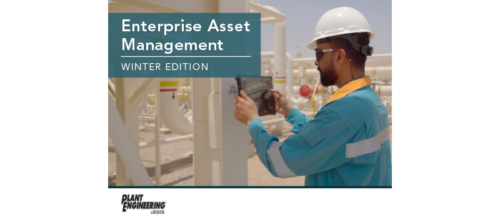Understanding the “alphabet soup” of maintenance management
Key concepts A CMMS helps maintenance organizations manage work orders, material control, and purchasing. With EAM, a company can go from being plant-centric to enterprise-centric.
Key concepts
A CMMS helps maintenance organizations manage work orders, material control, and purchasing.
With EAM, a company can go from being plant-centric to enterprise-centric.
A TSP builds, operates, manages, and supports technology tailored specifically to the company’s business needs.
Today, organizations are under pressure to achieve maximum return on their software investments. Every day, software users determine new ways to extend the use of their maintenance management software.
Like the rest of the software industry, a cadre of acronyms has come forth. Although their purpose is to make “maintenance-manager-speak” a little easier, they’re almost useless until you know what they mean. Such acronyms include the venerable computerized maintenance management system (CMMS), the newer enterprise asset management (EAM), and a host of others-some with acronyms and some without. These include “web enabled,” EAM/CMMS, ASP, and TSP.
CMMS
Available since the late 1970s, CMMS helps maintenance organizations manage work orders, material control, and purchasing. Think of it primarily as an execution system.
A work order module receives maintenance input, creates work orders, and tracks work in process. It also generates reports, including work status and equipment availability. Advanced systems may also provide cost and repair history.
The inventory module ensures that spares are always maintained at a level both sufficient and cost-effective. It automatically generates reports and issues requisitions whenever quantities drop below a predetermined reorder point. A materials reservation function additionally ensures sufficient stock is on hand for scheduled projects.
The purchasing module generates purchase orders (POs) for stocked and nonstocked items, special orders, and services. It tracks open POs, and generates a list of those past due. If buyers wish, they can access complete supplier and item order histories on demand.
EAM
Introduced during the past 5 yr, there is what is “called” EAM and what is really “true” EAM. If you remember, as the MRP software companies added modules, they changed their monikers to enterprise resource planning (ERP). Whether all provided true ERP is arguable.
A similar situation happened in the maintenance software world. Nonetheless, there is real EAM. Think of it as an interconnected data management system providing comparative information and reports across multiple locations, and allowing businesses to make informed decisions. With a true enterprise asset management system, a company can go from being plant-centric to enterprise-centric and reap the benefits that come with it.
For example, a true EAM solution allows the company to optimize inventory levels, and track and transfer assets and materials across the entire organization and eliminate overstock of costly parts. Also, the company can learn which machines cost the most to maintain and why, and then determine the purchase plans. The company’s database can be searched for information about each asset.
Using this knowledge base, plant engineers can find out what others have done to solve problems they are facing.
Web enabling
By web enabling their EAM/CMMS, maintenance personnel can access the applications described above, including work order and shop floor management, via the internet from anywhere at anytime, getting real-time information. A web-enabled solution can be implemented to achieve platform independence, which is a valuable attribute in today’s merger and acquisition environment.
Systems that have enterprise-level features combined with internet accessibility deliver advantages that have raised the bar for EAM/CMMS software. Having enterprise-wide inventory visibility through the internet means multiple storerooms can be viewed from anywhere one has a PC (the virtual office) to provide inventory management, make transfers, and aid in consolidated purchases. Maintenance and purchasing management can monitor inventory levels throughout the entire corporation and make more informed buying decisions. Wireless personal data assistants (PDAs) on the frontline can be used to issue requests instantly, receive responses rapidly, and provide the system with updated information on what is occurring in the field.
There are significant infrastructure savings to a web-enabled system. Instead of having the software physically installed on each system in every facility, the EAM/CMMS resides in one centralized location. Everybody in the company is playing for the same conductor. With a web-enabled application, all users get software upgrades, fixes, and updates consistently, at the same time. No longer do you need to load updates at each computer.
ASP
Assume the company would like to reap the benefits of an EAM/CMMS web-enabled system, but is concerned about a large upfront investment in both software and infrastructure. You are not alone. To help you, there are now scores of companies who will host your EAM/CMMS system for you. Click, and it’s like the software is in your own PC.
There are benefits to using application service providers (ASPs). You pay as you go without having to pull together an upfront investment and incur the costs of extra staff. Through an ASP, a company can take advantage of a fully integrated EAM/ CMMS. The company obtains a faster time-to-benefit and does not have to house and maintain the software.
There are some caveats to consider. The ASP simply provides access to the EAM/CMMS. You do not automatically get the latest updates and fixes, and cannot expect the EAM/CMMS software company to repair something over which they have no control. The data is also being held by somebody else, so there are security issues. Although most ASPs probably have more secure information systems than the company, it’s a question that should be thoroughly explored.
That’s why some EAM/CMMS suppliers provide what is called a hosted ASP. They act just like an ASP, but all fixes and updates are covered in the basic rental agreement. Users are always working on the latest version. Therefore, data security is superior.
TSP
In many respects, a company could look at a total service provider (TSP) as an ASP on steroids. A TSP builds, operates, manages, and supports end-to-end comprehensive technology solutions tailored specifically to the company’s business needs. Included can be all or parts of e-business, finance, accounting, billing and collection, contract management, supply chain integration, and EAM.
The company rents scalable, reliable, and adaptable solutions interfacing existing internal systems with those of your trading partners. As one simple example, net-based exchanges are appearing everywhere for the commodity products plant engineers need to keep their plants running. A TSP not only interfaces the company to one or more, but takes care of the complex billing mechanics and settlement terms involved with multiple parties in such supply chains.
-Edited by Jack Smith, Senior Editor, 630-320-7147, jsmith@cahners.com
Do you have experience and expertise with the topics mentioned in this content? You should consider contributing to our CFE Media editorial team and getting the recognition you and your company deserve. Click here to start this process.



